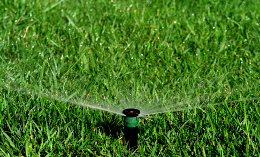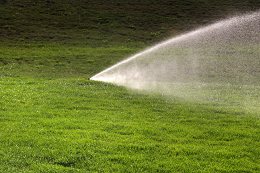 People plant Kentucky bluegrass seed lawns for their dark green color, the thick, dense growth, and their comfortable texture. But they are also known for being extremely water thirsty - probably more so than other types of grass seed. Consider some of these facts: Most lawns need an average of 1 to 1 ½” of water per week, while Kentucky bluegrass needs at least 2” of water per week, and sometimes even 2 ½” per week during the summer. In terms of total supplemental irrigation per year, Kentucky bluegrass needs 24 to 26” of supplemental irrigation, while other lawns need as little as 10”!
People plant Kentucky bluegrass seed lawns for their dark green color, the thick, dense growth, and their comfortable texture. But they are also known for being extremely water thirsty - probably more so than other types of grass seed. Consider some of these facts: Most lawns need an average of 1 to 1 ½” of water per week, while Kentucky bluegrass needs at least 2” of water per week, and sometimes even 2 ½” per week during the summer. In terms of total supplemental irrigation per year, Kentucky bluegrass needs 24 to 26” of supplemental irrigation, while other lawns need as little as 10”!
Why is Kentucky bluegrass so high maintenance in terms of water? Although it has very thick growth on top of the lawn, this species actually has a shallow root system relative to other turf grasses. Deeper roots are able to access more water and nutrients, but bluegrass lawns do not have that luxury. What is worse is that the root growth slows as temperatures increase, practically stopping once temperatures exceed 80ºF—which means you may be watering as much as every other day during the summer to keep your lawn from going dormant.
Luckily, there are a few tips you can try to make the most of your water use and to help your lawn become more drought tolerant. The first tip is to water only when your lawn shows signs of water deprivation. These signs include the grass turning a bluish-gray color, the leaves wilting, and the lawn not springing up after it is walked on—i.e., you can still see the mark of your footprints. Granted, these signs are going to show up more often in your Kentucky bluegrass lawn than they would in another type. But watering any more than this would only weaken the lawn further and discourage deeper root growth at all.
Next, water as deeply as you can without overflowing the soil. This might be up to 1” for a bluegrass lawn, and it will encourage the roots to grow deeper.
 If you have an automated sprinkler system, congratulations! Sprinkler systems can be more water efficient and save you some time and money. But to do that, they can’t be set on an automatic schedule and forgotten about. You should manually turn on the sprinkler system to water your lawn, and then you should turn it off when it has released the maximum amount of water your lawn can hold. Irrigating the lawn anywhere from 4:00 a.m. to 8:00 a.m.—or at the very least before noon—will lessen the chance of evaporation while not extending the lawn’s dew period, an ideal time for fungi and disease to grow.
If you have an automated sprinkler system, congratulations! Sprinkler systems can be more water efficient and save you some time and money. But to do that, they can’t be set on an automatic schedule and forgotten about. You should manually turn on the sprinkler system to water your lawn, and then you should turn it off when it has released the maximum amount of water your lawn can hold. Irrigating the lawn anywhere from 4:00 a.m. to 8:00 a.m.—or at the very least before noon—will lessen the chance of evaporation while not extending the lawn’s dew period, an ideal time for fungi and disease to grow.
Keep in mind that different areas of your lawn will need more or less water, depending on the shade, sun exposure, and soil. Shaded grass, for example, will need less water than grass growing in the sun. Calibrating your sprinkler system will help you understand the hourly rate of irrigation to your lawn, and you can adjust irrigation times accordingly.
If watering a Kentucky bluegrass lawn in the summer is too expensive or time consuming, consider letting the lawn go dormant. As long as it has been established for a few years, and as long as you irrigate the lawn with 1” of water every 2 to 3 weeks, your lawn should green up again in the fall when temperatures are cool enough.
Following all these tips will make watering your Kentucky bluegrass lawn less overwhelming and more effective.
